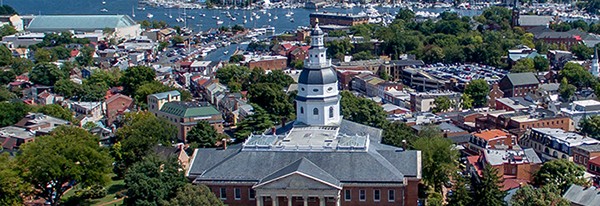Date:
Source: Capital Gazette, Brooks DuBose
This article was originally published in the Capital Gazette on Wednesday, December 29, 2021.
Of the 2 million or so visitors who come to Annapolis each year, a fair number are likely here to explore the capital city’s rich history. But they may be faced with the decision of where to begin.
Should they read about George Washington resigning his commission at the Maryland State House first? What about the history of Black residents at the Banneker-Douglass Museum? Will that leave time to learn about the city’s maritime lore at the Annapolis Maritime Museum?
Historic Annapolis and a host of partner organizations are hoping to give a definitive answer to those questions with “Annapolis: An American Story,” the permanent exhibit at the Museum of Historic Annapolis at 99 Main St.
The exhibit, housed in a former general store built in 1791 at City Dock, will serve as a launchpad to all of the historical landmarks scattered throughout the city, said Mary-Angela Hardwick, vice president of education and interpretation at Historic Annapolis, a nonprofit committed to the preservation of the city’s history.
Hardwick has been working to bring museum online for about three years. It offers three floors of exhibits broken up by different time periods. It will provide both an overview of nearly 400 years of history and direct visitors to the more than a dozen other locations where they can dive deeper into the city’s past.
“This shouldn’t be your only stop; this hopefully is a place that excites you to want to go out and see all these other partner sites,” Hardwick said in late December, about a month after the museum began opening for limited hours on weekends. “Here is where you can get that spotlight history of the community.”
Hardwick is aiming for a grand opening of the museum in March when the operation will expand to seven days a week.
Historic Annapolis has partnered with 11 historic locations throughout Annapolis where visitors will be encouraged to visit once they leave the museum. They include the Banneker-Douglass Museum, Maryland State House, Annapolis Maritime Museum & Park, Hammond-Harwood House, U.S. Naval Academy Museum and The Mitchell Gallery at St. John’s College, plus five sites operated by Historic Annapolis.
Throughout the exhibit, storyboards offer facts and photos from various parts of Annapolis history. In the bottom corner of some displays, there are QR codes that direct visitors to the website of partner sites and provide them with the operating hours, ticket prices and other important information. The boards also give the time it takes to walk there.
For instance, the State House is about a 6-minute walk. The Mitchell Gallery is about 11 minutes away.
Visitors are guided by a chronology that runs along the walls, dotted with artifacts, videos and interactive displays like flipbooks. Each tells the stories and themes of the times and highlights important dates and people, like Maryland’s four signers of the Declaration of Independence, and a digital map of civil rights protests and marches.
One of the museum’s centerpieces is a 250-pound gilded acorn that for more than two centuries rested at the top of the State House dome, a defining feature of Annapolis’ skyline. After 25 years in storage, the 4-foot-tall, nut-shaped artifact was returned to Annapolis and put on display in the museum’s foyer.
Viewing the acorn is free. Tickets can be purchased to view the rest of the museum, which includes an 8-minute video that explores all aspects of the city’s history.
The four rooms on the second and third floors are broken up by eras starting with the city’s early years from 1650 to 1800 as the country was first forming. In an adjacent room, 1800 to 1900, “Changing Times,” the creation of the Naval Academy and the upheaval caused by the Civil War are explained.
The “Toward Equal Justice” room on the third floor looks at the period from 1900 to 1970. It explores the city’s growing racial and ethnic diversity with the influx of immigrants and the rise of the Old Fourth Ward. And finally, in “The Power of Change” room, the exhibit highlights the past 50 years, nodding to the progress made in equal rights and the breaking of glass ceilings with the election of minorities and women to higher office.
At the center of each room is a large installation that captures its theme.
In one room sits a printing press to honor the role the early newspapers played in fighting for freedom of the press. In another, a stained-glass window on loan from Asbury United Methodist Church represents the city’s varied faith institutions. One room houses a large cutout showing civil rights leaders demonstrating and participating in sit-ins at the height of segregation. It offers a nod to the not-too-distant past when not all Annapolis residents were treated the same.
The exhibits do not shy away from the realities of history, including extensive violence at the country’s founding, acrimony and unrest during the Civil War, and the stains of racism, lynchings and segregation.
“I hope that people understand how this community is a reflection of the national story,” Hardwick said. “What’s going on here is mirroring in many ways what’s going on as the nation’s history unfolds.”
The museum installations are permanent; however, there will be some periodic changes, particularly at the Community Gallery, a hallway on the first floor, which will feature displays on notable Annapolitans, institutions, neighborhoods and faith organizations, Hardwick said.
Original hardwood floors remain from the building’s construction, but updates have been made, including an elevator and bathrooms that are compliant with the Americans with Disabilities Act.
Located at the foot of Main Street, the museum building has windows on three sides that look out onto the city. Window boxes in every room offer an explanation of what someone might have seen looking out over the past two centuries. For instance, one box features a photo from 1890 of the Market House and Middleton Tavern and, through the glass, are the buildings looking very similar in the present day.
“Hopefully as you then go out to the city, if you leave here, it gives you a greater appreciation,” Hardwick said. “Hopefully, it encourages people to look up and look around.”


